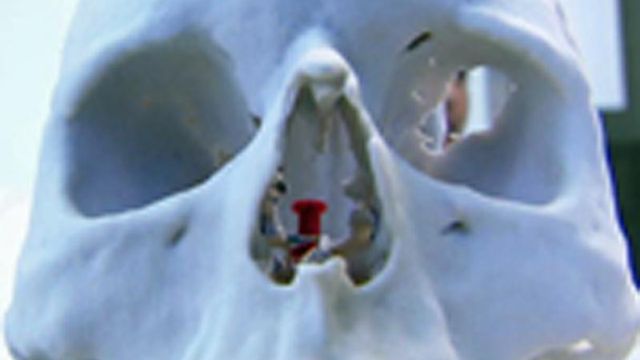Nose could be key to treating aneurysms
Brain aneurysms are dangerous. They affect only one in about 50 people and, when they rupture, kill about 40 percent of those people.
Posted — UpdatedSurgical options to keep an aneurysm from rupturing are risky, but UNC physicians are developing a new, less invasive treatment.
Aneurysms are like a bubble or blister on a blood vessel, and they typically develop in one area of the brain, called the skull base, behind the sinuses. An aneurysm shows no symptoms until it bursts, but many cases are diagnosed before bleeding starts.
In a standard surgical procedure to treat an aneurysm, a surgeon temporarily removes a large portion of the skull and lifts the brain in order to place a surgical clip on the aneurysm.
"We are putting pressure on the brain. Your brain is exposed," said Dr. Anand Germanwala, a neurosurgeon with the University of North Carolina at Chapel Hill School of Medicine.
Germanwala and UNC head-and-neck surgeon Dr. Adam Zanation have worked to develop an alternative treatment. They clip aneurysms by going through the nose.
"It's really two surgeons working simultaneously," Zanation said.
Two years ago, the duo used the nasal procedure on a woman who had one bleeding aneurysm and another that hadn't yet ruptured.
Using guided imaging and an endoscope with a camera, the surgeons advanced through the woman's nasal passages and drilled through to the base of her brain. "Then, we are able to go in and put our clip on the aneurysms," Germanwala said.
They published the results of the surgery in the journal Neurology.
"This patient has surgical clips, and I've seen her two years out from the procedure, and she's doing fantastic," Germanwala said.
Since only one patient has undergone this procedure, the preferred ways to treat an aneurysm are still the open-skull approach and an endovascular coiling procedure, in which a catheter is threaded through the femoral artery up to the brain.
The nasal approach requires special team work between surgeons with two different specialties, and many more patients are needed to determine its safety. Germanwala and Zanation said they are evaluating patients on a case-by-case basis for the procedure.
• Credits
Copyright 2024 by Capitol Broadcasting Company. All rights reserved. This material may not be published, broadcast, rewritten or redistributed.





